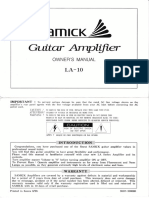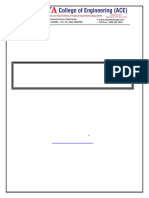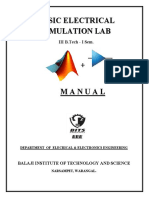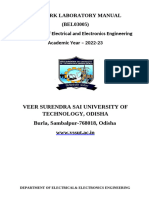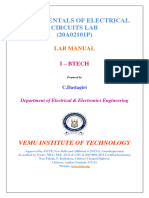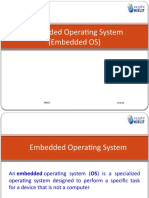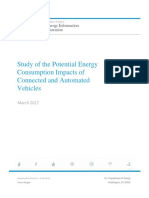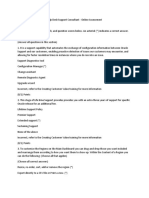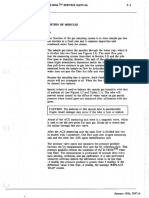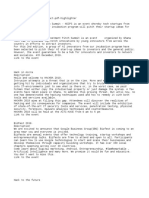BEE Lab Manual - 2019-20
BEE Lab Manual - 2019-20
Uploaded by
Venky DasamCopyright:
Available Formats
BEE Lab Manual - 2019-20
BEE Lab Manual - 2019-20
Uploaded by
Venky DasamOriginal Description:
Original Title
Copyright
Available Formats
Share this document
Did you find this document useful?
Is this content inappropriate?
Copyright:
Available Formats
BEE Lab Manual - 2019-20
BEE Lab Manual - 2019-20
Uploaded by
Venky DasamCopyright:
Available Formats
Basic Electrical Engineering Laboratory (18ELE17/27)
B M S Institute of Technology & Management
Yelahanka, Bengaluru-64
Department of Electrical & Electronics Engineering
I/II SEMESTER
Basic Electrical Engineering Laboratory
(18ELEL 17/27)
LABORATORY MANUAL
Prepared By:
Prof. Prashanth N A
Prof. Nagaraj D C
Prof. Manjunath Babu P HOD, EEE
EEE, BMSIT&M, Bengaluru. 1
Basic Electrical Engineering Laboratory (18ELE17/27)
Vision of the Department
To emerge as one of the finest Electrical & Electronics Engineering Departments
facilitating the development of competent professionals, contributing to the betterment of society.
Mission of the Department
Create a motivating environment for learning Electrical Sciences through teaching,
research, effective use of state of the art facilities and outreach activities.
Course Outcomes:
After the completion of the course the students will be able to
CO1 Measure basic circuit parameters using suitable methods.
Verify the relationship amongst the circuit parameters in single phase and three phase
CO2
circuits.
CO-PO Mapping:
PO1 PO2 PO3 PO4 PO5 PO6 PO7 PO8 PO9 PO10 PO11 PO12
CO1 3 2
CO2 3 2
Cii 3 2
EEE, BMSIT&M, Bengaluru. 2
Basic Electrical Engineering Laboratory (18ELE17/27)
Graduates of the program of Electrical and Electronics Engineering will,
Have successful professional careers in Electrical Sciences, and Information
PEO1*
Technology enabled areas and be able to pursue higher education.
Demonstrate ability to work in multidisciplinary teams and engage in lifelong
PEO2
learning.
PEO3 Exhibit concern for environment and sustainable development.
* Program Educational Objectives
After the successful completion of the Program, the graduate will be able to,
Apply knowledge of mathematics, science and engineering principles to the
PO1**
solution of engineering problems in electrical and IT enabled areas.
Identify and solve complex engineering problems using first principles of
PO2
mathematics and engineering sciences.
Design system components and solve complex engineering problems that meet
PO3
specific societal and environmental needs.
PO4 Conduct experiments, analyse, and interpret data to provide valid conclusion
Apply appropriate modern engineering tools to complex engineering activities
PO5
with an understanding of the limitations.
Demonstrate understanding of societal health, safety, legal and consequent
PO6
responsibilities relevant to the professional engineering practice.
Understand the impact of engineering solutions in a societal context and
PO7
demonstrate the knowledge of and need for sustainable development.
Understand social issues and ethical principles of electrical engineering
PO8
practice.
Function effectively as an individual and as a member or leader in diverse
PO9
teams to accomplish a common goal.
Communicate effectively with diverse audiences and be able to prepare
PO10
effective reports and design documentation.
Demonstrate knowledge and understanding of engineering and management
PO11 principles and apply these as a member and leader in a team to manage projects
in multi-disciplinary environments.
Recognize the need to engage in independent and lifelong learning in the
PO12
context of technological change.
** Program Outcomes
EEE, BMSIT&M, Bengaluru. 3
Basic Electrical Engineering Laboratory (18ELE17/27)
Instruction to Students
The students are informed to note the following and abide by:
1. Khaki uniform is mandatory for laboratory classes. (Half sleeve shirts
tucked inside the pant)
2. Good qualities shoes (preferably leather shoes) are mandatory.
3. Regularity and Punctuality should be maintained.
4. Students should come prepared for the laboratory sessions and
observation books are to be maintained neatly and up to date .
5. Students should write their Names, USN& sign while taking the
apparatus.
6. Prior permission from the teaching staff is required before making circuit
connection.
7. Power supply is to be Switched ON only after the connections are
checked by the Staff / Instructor.
8. When power supply is on students are not supposed to touch the circuit
connection/terminals on panel board.
9. Any metallic ornaments like bracelets, bangles, rings, chains, metallic
loose wrist watches should be avoided during the conduction of
experiment.
10. After completion of conducting the experiment, students should Switch
OFF the power supply and then remove the circuit connection.
Calculation and graph are to be completed within the permitted time.
11. The completed lab record should be submitted in every subsequent
laboratory sessions.
12. Internal Marks allocation (Max 40)
(Regular Conduction 20Marks, Final Lab Internals: 20Marks)
13. Students’ not satisfying 85% attendance will be detained under NSAR
case.
EEE, BMSIT&M, Bengaluru. 4
Basic Electrical Engineering Laboratory (18ELE17/27)
GUIDE LINES FOR THE EXPERIMENTS AND REPORT PREPARATION
1. Preparation for the experiment: Before conducting the experiment, the student is required to have
read the experiment background and procedure from the experiment manual and studied the
related theory. The lab instructor may, during the experiment, ask students questions pertaining to
the procedure and theory. The lab instructor may give negative points to and even prevent an
unprepared student from conducting the experiment. Tardy students may not be allowed to
perform the experiment.
2. Laboratory teams: The class will be divided in teams of three or four students. The composition of
the teams (which students will team up) is decision of Lab Instructor. Each lab experiment
requires a report. The lab reports are due on the next lab meeting. The lab report for the final
experiment is due a week after the final lab meeting. Each student submits one report per
experiment (unless otherwise required) in the record. The grade of the report is given to all
members of the team. Late reports are penalized by taking few points off per each day past the due
date of the report. The other grade components of the experiments are given to the students
individually. If a student misses or is dismissed from an experiment, the grade of that student shall
be zero for that experiment.
3. Preparation of the report: The report must be produced in the lab Records of the Institute. Tables
showing data or results, as well as figures and graphs should be produced. Include captions and
titles for figures, graphs and tables as well as numbers for equations. The preferred language style
is the use of the present tense and third person. The report must contain the following sections:
• Cover page: Include number and title of the experiment, date the experiment was
performed and the names of the team members.
• Objective: Give a short description of the purpose of the experiment.
• Theoretical background: Give a brief description of the relevant theory.
• The experimental procedure: Summarize what was done for each experiment procedure.
Do not copy or repeat the description from the lab manual. Report the measurement and
other experimental data. Tabulate measurements if necessary. Include table number and
title over tables.
• Analysis of experimental data: Analyze the data. Compare with theoretical results. Label
axis. Show units. Add remarks and calculations on each procedure if necessary.
Conclusions: Summarize the experiment and the results. Discuss the factual knowledge
gained.
EEE, BMSIT&M, Bengaluru. 5
Basic Electrical Engineering Laboratory (18ELE17/27)
List of Experiments:
Sl. Page
Name of the Experiment
No. No.
1 Verification Of Kirchhoff’s Voltage And Current Law 7
Measurement Of 3 Phase Power By Two Wattmeter
2 9
Method
3 Three – Phase Star / Delta Connections 11
4 Two Way And Three Way Control Of Lamps 14
Effect Of Open Circuit And Short Circuit In Simple
5 16
Circuits
Measurement Of Resistance And Inductance Of A Choke
6 18
Coil
Measurement Of Current, Power And Power Factor Of
7 20
Lamps
8 Measurement of Earth Resistance 22
EEE, BMSIT&M, Bengaluru. 6
Basic Electrical Engineering Laboratory (18ELE17/27)
Experiment - 1
VERIFICATION OF KIRCHHOFF’S VOLTAGE AND CURRENT LAW
AIM: To verify Kirchhoff’s Current law and Kirchhoff’s Voltage law
Apparatus Required:
Sl. No Particular Range Quantity
1 Regulated Power 0-30V, 2A 01
Supply
2 Volmeter 0-30V 03
3 Ammeter 0-2A 03
4 Rheostat 50Ω / 2A, 100Ω / 01 each
2A, 150Ω / 2A
5 Connecting wires -- Few
THEORY: (Detailed Theory to be included referring Text Book)
VERIFICATION OF KCL:
Circuit diagram
Tabular column:
Sl. No. RPS Voltage I1 (A) I2 (A) I3 (A) I1= I2+ I3
in volts
1 10
2 15
3 20
4 25
5 30
Verification: I1= I2+ I3, if satisfied, KCL is verified.
EEE, BMSIT&M, Bengaluru. 7
Basic Electrical Engineering Laboratory (18ELE17/27)
VERIFICATION OF KVL:
Circuit diagram
TABULAR COLUMN:
Sl. No. RPS Voltage V1 V2 V3 V= V1+ V2+ V3
in volts(V) in volts in volts in volts
1 10
2 15
3 20
4 25
5 30
Verification: V= V1 + V2 + V3, if satisfied, KVL is verified.
PROCEDURE:-
1. Make the connections as given in the circuit diagram.
2. Initially keep the voltage control knob in the minimum position and current knob in the maximum
position.
3. Switch ON the power supply. Increase the voltage in uniform steps such as to cover wide range
as possible in the meters.
4. Note down meter readings in the tabular column.
5. Repeat the same by varying Rheostats position.
6. Repeat the same for different voltages by varying power supply.
RESULT:
EEE, BMSIT&M, Bengaluru. 8
Basic Electrical Engineering Laboratory (18ELE17/27)
Experiment 2
MEASUREMENT OF 3 PHASE POWER BY TWO WATTMETER METHOD
Aim: To measure Three phase power by using Two Wattmeter method.
Apparatus Required:
Sl. No Apparatus Range Quantity
1 Wattmeter 0-600V/10A UPF 02
2 Ammeter (MI) 0-10A 01
3 Voltmeter (MI) 0-600V 01
4 Three Phase Load 0-10A 01
5 Connecting wires -- Few
Circuit Diagram:
Theory: Detailed Theory to be included referring Text Book.
Procedure:
1. Make the connections as shown in the circuit diagram.
2. Ensure all the load switches are if OFF position before turning on the supply.
3. Switch ON the supply.
4. Turn ON the load in steps and at each step note down the meter readings until the current reaches
the rated value.
5. Turn OFF all the load switches in steps and switch OFF the supply.
EEE, BMSIT&M, Bengaluru. 9
Basic Electrical Engineering Laboratory (18ELE17/27)
Tabular Column:-
Sl. VL I W1 W2 W= W1+ W2 𝐜𝐨𝐬 𝜱 Calculated
No. Watts
√𝟑 VL IL 𝐶𝑜𝑠𝛷
Calculation:-
Total Power = P = (W1 + W2) Watts.
Power Factor
√𝟑(𝑾𝟏−𝑾𝟐)
𝐜𝐨𝐬 𝜱 = 𝐜𝐨𝐬 [𝐭𝐚𝐧−𝟏 ( )]
𝑾𝟏+𝑾𝟐
Result:
EEE, BMSIT&M, Bengaluru. 10
Basic Electrical Engineering Laboratory (18ELE17/27)
Experiment 3
THREE – PHASE STAR / DELTA CONNECTIONS
Aim : To determine phase and line quantities in three phase star and delta connected load.
Apparatus Required:
Sl. No Apparatus Range Quantity
1 Autotransformer 0-415V 01
2 Ammeter (MI) 0-2A 02
3 Voltmeter (MI) 0-600V 02
4 Three Phase Load --- 01
5 Connecting wires -- Few
Circuit Diagram:
A) STAR CONNECTION
B) DELTA CONNECTION
Theory: Detailed Theory to be included referring Text Book
EEE, BMSIT&M, Bengaluru. 11
Basic Electrical Engineering Laboratory (18ELE17/27)
Procedure :
1. Make the connections as given in the circuit diagram with auto transformer and meters.
2. Make Star connection in 3Φ Resistive load Bank
3. Initially keep the auto transformer at minimum position.
4. Switch ON the MCB. Slowly vary the auto transformer and set the voltage at 50Volts.
5. Switch ON Load in all 3 phases and note down meter readings.
6. Repeat the same for 2, 3, 4 and all 5 switches ON and note down the readings.
7. Now vary the input voltage to full voltage in steps and Repeat the experiment for different load
current.
8. Repeat the above procedure for Load Connected in Delta fashion.
Calculations: Star Connection
OBSERVATIONS:
Practical Analytical
Sl. No VL V Ph IL I Ph VL V Ph IL I Ph
volts volts Amps Amps volts volts Amps Amps
1
2
3
4
CALCULATION:
Vph
IL= IPh = …………. Amps Iph = = ……………….. Amp.
Rph
VL = ………. Volts , VPh = VL / √3 = ………………..=……….volts
Delta Connection
OBSERVATIONS:
Practical Analytical
Sl. No VL V Ph IL I Ph VL V Ph IL I Ph
volts volts Amps Amps volts volts Amps Amps
1
EEE, BMSIT&M, Bengaluru. 12
Basic Electrical Engineering Laboratory (18ELE17/27)
CALCULATION:
Vph
VL = VPh = ………………..volts Iph = R = ……………….. Amp.
ph
00000
IL = √3IPh = …………….. = ……………… Amp.
Results:
EEE, BMSIT&M, Bengaluru. 13
Basic Electrical Engineering Laboratory (18ELE17/27)
Experiment 4
TWO WAY AND THREE WAY CONTROL OF LAMPS
Aim : To execute the control of lamp using Two way and Three way switches
Apparatus Required
Sl. No Apparatus Quantity
1 Two Way Switch 02
2 Intermediate Switch 01
3 Lamp 01
4 Connecting Wires Few
Circuit Diagram:
Two Way Control
Three Way Control
EEE, BMSIT&M, Bengaluru. 14
Basic Electrical Engineering Laboratory (18ELE17/27)
Theory: Detailed Theory to be included referring Text Book.
Procedure:
1. Connections are made as shown in the circuit diagram.
2. Switch ON the supply source.
3. For all the positions of the Switches S1 and S2 mentioned in Truth Tables observe and note the
Lamp condition and note the traced path.
4. Switch OFF the supply.
Observations:
Truth Table:
Two Way Control
Sl. No Switch S1 Switch S2 Condition of Path Traced
Lamp
1 A C
2 A D
3 B D
4 B C
Three Way Control
Switch S1 Switch S2 Switch S3 Condition Path Traced
Sl. No
of Lamp
1 A C EF, GH
2 A D EF, GH
3 B D EF, GH
4 B C EF, GH
5 B C EH, GF
6 B D EH, GF
7 A D EH, GF
8 A C EH, GF
Conclusion:
EEE, BMSIT&M, Bengaluru. 15
Basic Electrical Engineering Laboratory (18ELE17/27)
Experiment 5
EFFECT OF OPEN CIRCUIT AND SHORT CIRCUIT IN SIMPLE CIRCUITS
Aim: To study the effect of open circuit and short circuit in the simple circuit
Apparatus Required:
Sl. No Apparatus Range Quantity
Single Phase 0-300V, 10A 01
1
Autotransformer
2 Voltmeter (MI) 0-300V 01
3 Ammeter (MI) 0-10A 01
4 SPST Switches 0-10A 01
5 Connecting wires -- Few
Circuit Diagram:
Open Circuit
Short Circuit
EEE, BMSIT&M, Bengaluru. 16
Basic Electrical Engineering Laboratory (18ELE17/27)
Theory: Detailed Theory to be included referring Text Book.
Procedure:
Open Circuit
1. Make the connections as shown in the circuit diagram (Open Circuit).
2. Keep Switches S1 and S2 open.
3. Switch ON the supply.
4. Note down the meter readings.
5. Switch OFF the supply.
Short Circuit
1. Make the connections as shown in the circuit diagram (Short Circuit).
2. Keep Switches S1 and S2 open.
3. Switch ON the supply.
4. Close the Switch S1 and keep Switch S2 Open.
5. Note the readings of all the meters.
6. Close the Switch S2 and note down the reading of all the meters.
7. Switch OFF the supply.
Observations:
Open Circuit
Sl. No Voltage (V) Current (A)
Short Circuit
Voltage (V) Current (A)
S1 Closed, S2 Open
S1 Closed, S2 Closed
Conclusion:
EEE, BMSIT&M, Bengaluru. 17
Basic Electrical Engineering Laboratory (18ELE17/27)
Experiment 6
MEASUREMENT OF RESISTANCE AND INDUCTANCE OF A CHOKE COIL
Aim: To Measure Resistance and Inductance of a Choke Coil using Three Voltmeter Method.
Apparatus Required
Sl. No Apparatus Range Quantity
1 Choke Coil -- 01
2 Voltmeters (MI) 0-300V 03
3 Rheostat 0-220Ω 01
4 Connecting wires -- Few
5 Ammeters 0-5A 01
Circuit Diagram:
Theory: Detailed Theory to be included referring Text Book.
Procedure:
1. Make the connections as shown in the circuit diagram.
2. Switch ON the supply.
3. Apply input voltage by varying the autotransformer of value say 100V.
4. Note the readings of all the meters.
5. Repeat the above procedure for two more voltages.
6. The inductance of the coil is taken as the average of the two inductance values obtained.
7. Bring back the autotransformer to its minimum position and switch OFF the supply.
8. Repeat the procedure from step-2 to step-4 for 50% tapping in Choke.
9. Measure the resistance(R) of external rheostat using multimeter.
EEE, BMSIT&M, Bengaluru. 18
Basic Electrical Engineering Laboratory (18ELE17/27)
Observations:
Sl. No V1 (V) V2 (V) V3 (V) I (A) COSθ R (Ω) L (H) rL(Ω)
1 L1= rL1=
Half Length
2 L2= rL2=
Full Length
V1
IXL
V2 Ir
𝑉12− 𝑉22− 𝑉32 𝑉2 𝑉3
COS 𝜃 = 𝐼= Z=
2𝑉2𝑉3 𝑅 𝐼
Where Z is impedance of choke coil
Choke Coil Resistance r = Z Cos 𝜃
Choke Coil of Reactance 𝑋𝑙 = Z sin 𝜃
𝐿 𝑋
Inductance of Choke Coil L = 2𝛱𝑓
L = ………………. H
Conclusion:
EEE, BMSIT&M, Bengaluru. 19
Basic Electrical Engineering Laboratory (18ELE17/27)
Experiment 7
MEASUREMENT OF CURRENT, POWER AND POWER FACTOR OF LAMPS
Aim: To measure current, Power and Power Factor of Incandescent Lamp, Fluorescent Lamp and
LED Lamp.
Apparatus Required:
Sl. No Apparatus Range Quantity
1 Voltmeter (MI) 0-300V 01
2 Ammeter (MI) 0-1A 01
3 Wattmeter 0-300V, 1A, UPF 01
4 Lamps -- 01 Incandescent
01 Fluorescent
01 LED
5 Connecting wires -- Few
Circuit Diagram:
Connection Diagram
EEE, BMSIT&M, Bengaluru. 20
Basic Electrical Engineering Laboratory (18ELE17/27)
Theory: Detailed Theory to be included referring Text Book.
Procedure:
1. Connections are made as shown in the circuit diagram (connect incandescent lamp).
2. Switch on the supply.
3. Observe and note the readings of all the meters.
4. Switch OFF the supply.
5. Repeat the above procedure for Fluorescent lamp and LED lamp.
Observation:
Sl. No Lamp Voltage Current Power Power Factor
V (V) I(A) P (W) CosΦ=P/(V.I)
1 Incandescent
2 Fluorescent
3 LED
Conclusion:
EEE, BMSIT&M, Bengaluru. 21
Basic Electrical Engineering Laboratory (18ELE17/27)
Experiment 8
MEASUREMENT OF EARTH RESISTANCE
Aim: To measure earth resistance of an installation with the help of an earth tester.
Apparatus Required:
Sl. No. Name of the Apparatus Range Quantity
1 Earth Tester - 1
2 Spikes - 3
3 Connecting wires - Few
Connection Diagram:
Theory:
All the electrical installations and appliances should be earthed properly for ensuring human
safety. A separate wire, known as earth wire runs along the supply line and is ultimate connected to the
ground through an earth electrode, The total resistance of the earthing system should be small so that in
the event of any fault, the fault current is sufficiently high to blow off the fuse. The earth resistance is the
resistance offered by the soil and the electrode to the flow of earth leakage current which will flow in case
of earth fault only.
EEE, BMSIT&M, Bengaluru. 22
Basic Electrical Engineering Laboratory (18ELE17/27)
The earth tester is a special type of ohmmeter which sends ac through earth and dc through the
measuring instruments as shown in fig. the direction of flow of current in the ground keeps on alternating
due to current reverse whereas current directions in the two reverser and potential reverser are mounted
on the main shaft of hand driven dc generator.
The working principle of an earth tester is identical to that of megger. There are two moving coil
viz. potential and current coil which are deflected in the magnetic field of a permanent magnet. The hand
driven generator or a set of batteries supply power to these coils. It has got four terminals P1, E1, P2 and
E2. Terminals P1 and E1 are shorted to form a common point which is connected to the earth electrode
under test. The other two terminals E2 and P2 are connected to the auxiliary electrode A and B
respectively. The value of earth resistance is indicated directly on the scale when the test button is
pressed.
The value of earth resistance depends upon the soil condition and its moisture contents. In hilly areas
the earth resistance is higher if electrodes are not place properly in contact with the earth. Water content
in the soil decreased the earth resistance. The normal value of earth resistance should lie between 1 to 2Ω.
Procedure:
1. Connections are made as shown in the connection diagram.
2. Switch on the earth tester.
3. Adjust the resistance range button between 10Ω to 1000Ω and select suitable range.
4. Change the position of electrode B by 1m on the either side and observe the earth resistance by
pressing the test button.
5. Take the mean of observations of earth resistance.
Observations:
Sl. No Earth Resisance Mean Value, R=( R1+ R2+ R3)/3
(Ω) (Ω)
1 R1 =
2 R2 = R=
3 R3 =
Conclusion:
EEE, BMSIT&M, Bengaluru. 23
You might also like
- lk3054xs Manual Tractor KiotiDocument52 pageslk3054xs Manual Tractor KiotiFernando G.No ratings yet
- Lesson Plan - OSDocument3 pagesLesson Plan - OSAmor Dianne100% (2)
- Mobile Services: Your Account Summary This Month'S ChargesDocument1 pageMobile Services: Your Account Summary This Month'S ChargesBeyza Gemici100% (1)
- Handbook of Electronics Formulas and Calculations - Volume 1From EverandHandbook of Electronics Formulas and Calculations - Volume 1Rating: 5 out of 5 stars5/5 (1)
- Amplificador SamickDocument2 pagesAmplificador SamickGeorgeFlowers100% (1)
- EMLab II Manual - 19022019 - FinalDocument40 pagesEMLab II Manual - 19022019 - FinalNikitha E KattimaniNo ratings yet
- Be Lab Manual EditDocument111 pagesBe Lab Manual Editmihirjoshi1806No ratings yet
- Analog Electronic Circuits Lab ManualDocument99 pagesAnalog Electronic Circuits Lab Manualchandrasekharb2004No ratings yet
- Lab Manual: Mit School of EngineeringDocument10 pagesLab Manual: Mit School of EngineeringJohnNo ratings yet
- BEE 3110005 Lab ManualDocument64 pagesBEE 3110005 Lab Manualdattkadia1122006No ratings yet
- Analog Electronics Lab Main ManualDocument53 pagesAnalog Electronics Lab Main Manualkumawatlakshay23No ratings yet
- Updated ECA ManualDocument23 pagesUpdated ECA Manualctmusic2005No ratings yet
- BEE Lab ManualDocument63 pagesBEE Lab Manualpuraniharsh441No ratings yet
- Power Electronics &Simulation LabDocument80 pagesPower Electronics &Simulation LabBandavva VyapariNo ratings yet
- 21 Scheme Bee Lab Manual FinalDocument101 pages21 Scheme Bee Lab Manual FinalSuman naidu RNo ratings yet
- Basic Electronics (3110016) - Lab Manual - V1Document111 pagesBasic Electronics (3110016) - Lab Manual - V1puhouser460No ratings yet
- 23EE102 - Basics of Electrical Circuits Laboratory - Lab Manual - FINALDocument62 pages23EE102 - Basics of Electrical Circuits Laboratory - Lab Manual - FINALSukhee SakthivelNo ratings yet
- Bee Lab Manual Printing PDFDocument59 pagesBee Lab Manual Printing PDFVispendra SinghNo ratings yet
- Control Systems Lab ManualDocument55 pagesControl Systems Lab ManualNarendra ChaurasiaNo ratings yet
- SP LabDocument8 pagesSP LabVibhiNo ratings yet
- Power Electronics Lab ManualDocument114 pagesPower Electronics Lab ManualramNo ratings yet
- PS2 Lab Manual VI Sem-3 (1)Document60 pagesPS2 Lab Manual VI Sem-3 (1)yenumulasaiteja978No ratings yet
- AEC Lab Manual - CompleteDocument116 pagesAEC Lab Manual - CompleteJinithaNo ratings yet
- Laboratory Manuals: Basic Electrical Engineering LabDocument39 pagesLaboratory Manuals: Basic Electrical Engineering Labkeshavbansal039No ratings yet
- Electrcial Circuits Lab Manual 2-1Document79 pagesElectrcial Circuits Lab Manual 2-1اياد النعيميNo ratings yet
- ECE 392 ABET Course SyllabusDocument4 pagesECE 392 ABET Course Syllabusdnow4pNo ratings yet
- Lab - 0Document5 pagesLab - 0Samarth SamaNo ratings yet
- Engineering Physics Experiments Lab Manual 1 EditedDocument40 pagesEngineering Physics Experiments Lab Manual 1 EditedMOHIT VERMANo ratings yet
- EdcDocument150 pagesEdcMad DamnNo ratings yet
- Relay and High Voltage Laboratory 15eel77 PDFDocument95 pagesRelay and High Voltage Laboratory 15eel77 PDFM.KNo ratings yet
- ANALOG CIRCUITS LAB (18ECL48) Manual 2021-22-STUDENTDocument95 pagesANALOG CIRCUITS LAB (18ECL48) Manual 2021-22-STUDENTPate VishnuNo ratings yet
- MICROWAVE LAB RECORD FinalDocument41 pagesMICROWAVE LAB RECORD FinalMathiNo ratings yet
- Mse 2201Document7 pagesMse 2201Netsanet GetnetNo ratings yet
- Lab Manual Eee111 Jun 2008 Corrected 8Document93 pagesLab Manual Eee111 Jun 2008 Corrected 8Fatin Nur KhalidaNo ratings yet
- Engineering Physics Experiments Lab Manual 1Document40 pagesEngineering Physics Experiments Lab Manual 1dk3495839No ratings yet
- Network Theory 3131103 Lab ManualDocument74 pagesNetwork Theory 3131103 Lab Manualchauhan13106No ratings yet
- EC8462Document86 pagesEC8462ur's joeNo ratings yet
- SRM - Electric Circuits Lab Manual - EditedDocument71 pagesSRM - Electric Circuits Lab Manual - Editedsaishrish817No ratings yet
- Basic Electrical Simulation Lab 3-1Document102 pagesBasic Electrical Simulation Lab 3-1nadeemq_0786No ratings yet
- Basic Electrical Simulation Lab 3-1 PDFDocument102 pagesBasic Electrical Simulation Lab 3-1 PDFAjay KatherlaNo ratings yet
- Electrical Machines Lab 4rd Sem-1Document33 pagesElectrical Machines Lab 4rd Sem-1Shubham kumarNo ratings yet
- LIC+C Lab Manual-17 FinalDocument59 pagesLIC+C Lab Manual-17 FinalDhanush Gowda D TNo ratings yet
- 4ee4-24 Emi Lab ManualDocument67 pages4ee4-24 Emi Lab ManualBackup DataNo ratings yet
- Course File of Electrical Circuit Analysis by MRINAL RANJANDocument22 pagesCourse File of Electrical Circuit Analysis by MRINAL RANJANyogesh7757016278No ratings yet
- PE LAb Diploma 36Document67 pagesPE LAb Diploma 36Yeduresapu SantoshNo ratings yet
- NT_Lab_Manual Updated 13 08 24Document19 pagesNT_Lab_Manual Updated 13 08 24Pabitra Kumar RathNo ratings yet
- PSS Lab Manual R15Document57 pagesPSS Lab Manual R15s masumNo ratings yet
- BE8261 - BEEIE Lab Manual For II Sem Mech/ AeroDocument123 pagesBE8261 - BEEIE Lab Manual For II Sem Mech/ AeroRAJARAJAN RNo ratings yet
- Power SystemsDocument47 pagesPower Systemsmanish_chaturvedi_6No ratings yet
- Lab Manuals (Latest)Document35 pagesLab Manuals (Latest)Pratham ChhabraNo ratings yet
- Edc 2Document103 pagesEdc 2abhi_engg06No ratings yet
- Student Observation Record: Electrical Machines-Ii LabDocument52 pagesStudent Observation Record: Electrical Machines-Ii LabAnushkaNo ratings yet
- Edc Lab Observation Gpcet (2016-17)Document67 pagesEdc Lab Observation Gpcet (2016-17)prasannakumar_7No ratings yet
- DIP Lab Manual UpdatedDocument42 pagesDIP Lab Manual Updateddabangraika34No ratings yet
- ADE Student Lab ManualDocument58 pagesADE Student Lab ManualAnanya GurramNo ratings yet
- 5ee4-21 Power System-1 Lab Zero Lab and Experiment 1Document28 pages5ee4-21 Power System-1 Lab Zero Lab and Experiment 1yogessh kumawatNo ratings yet
- Fec LabDocument72 pagesFec LabsivaNo ratings yet
- Gujarat Technological UniversityDocument7 pagesGujarat Technological Universitydnow4pNo ratings yet
- Ee LabDocument71 pagesEe LabsivaNo ratings yet
- EDTC Lab ManualDocument85 pagesEDTC Lab ManualNarendra Verma100% (1)
- AC Electrical Machines Lab Manual 3 - 1Document65 pagesAC Electrical Machines Lab Manual 3 - 1Rockstar RichNo ratings yet
- Electrical Engineering Lab (2 Year Chemical)Document23 pagesElectrical Engineering Lab (2 Year Chemical)VishalNo ratings yet
- Arduino Measurements in Science: Advanced Techniques and Data ProjectsFrom EverandArduino Measurements in Science: Advanced Techniques and Data ProjectsNo ratings yet
- Practical Control of Electric Machines: Model-Based Design and SimulationFrom EverandPractical Control of Electric Machines: Model-Based Design and SimulationNo ratings yet
- M02-S01-Introduction To Embedded OSDocument32 pagesM02-S01-Introduction To Embedded OSmanishNo ratings yet
- Interoperability and Harmonization WP 7 Global AtmDocument41 pagesInteroperability and Harmonization WP 7 Global AtmCTANo ratings yet
- Roles Responsibility Letter FormDocument2 pagesRoles Responsibility Letter FormAkshay ShahNo ratings yet
- AvCount Profile PDFDocument8 pagesAvCount Profile PDFal yasaNo ratings yet
- Belimo G350B-N SVX24-SR Assembly En-UsDocument6 pagesBelimo G350B-N SVX24-SR Assembly En-UsWilber MartínezNo ratings yet
- Automated VehiclesDocument96 pagesAutomated Vehiclespvr2k1No ratings yet
- Training Report On Machine LearningDocument27 pagesTraining Report On Machine LearningBhavesh yadavNo ratings yet
- Dual Layer Multi User Mimo.Document17 pagesDual Layer Multi User Mimo.MahdiehNo ratings yet
- MRO - Maintenance, Repair & OverhaulDocument20 pagesMRO - Maintenance, Repair & OverhaulAman OjhaNo ratings yet
- Print - Udyam Registration CertificateDocument2 pagesPrint - Udyam Registration CertificateParminder SinghNo ratings yet
- Unit III Transport LayerDocument18 pagesUnit III Transport LayerPRATHAM DHARMANINo ratings yet
- Designed by Pam OlivieriDocument15 pagesDesigned by Pam OlivieriAlaa IsmailNo ratings yet
- Cooling SystemDocument13 pagesCooling SystemzhiNo ratings yet
- Configuration Wizard: Connexion Download & InstallationDocument2 pagesConfiguration Wizard: Connexion Download & InstallationSpit FireNo ratings yet
- Thapar University, Patiala: Branch / Specialisation Mechanical (Ug /PG)Document5 pagesThapar University, Patiala: Branch / Specialisation Mechanical (Ug /PG)Mohit AgarwalNo ratings yet
- Polaroid XS100i Extreme Edition HD 1080pDocument73 pagesPolaroid XS100i Extreme Edition HD 1080pVictor SantosNo ratings yet
- Sun ZFS Storage Appliance Help Desk Support ConsultantDocument15 pagesSun ZFS Storage Appliance Help Desk Support ConsultantAmapiano TriconNo ratings yet
- Membrane Pressure Relief Valves: VHS-CDocument4 pagesMembrane Pressure Relief Valves: VHS-C88jdccNo ratings yet
- Auto Electrical Test BenchDocument1 pageAuto Electrical Test Benchilesh shahNo ratings yet
- The Decentralized Global Content Ecosystem: White PaperDocument32 pagesThe Decentralized Global Content Ecosystem: White PaperMr HungggNo ratings yet
- BG 64 DetailsDocument4 pagesBG 64 DetailsVisakh Vijay100% (1)
- Revised Placement Brochure 2021-22 - CompressedDocument24 pagesRevised Placement Brochure 2021-22 - Compressedkaransonone121No ratings yet
- Datex Capnomac Ultima Service Manual Part 2Document73 pagesDatex Capnomac Ultima Service Manual Part 2Carlos Henrique Candido sabinoNo ratings yet
- Ghana Tech WorkshopsDocument2 pagesGhana Tech WorkshopsGabrielNo ratings yet
- Digital TransmissionDocument42 pagesDigital TransmissionChungQuốcNguyễnNo ratings yet
- Case Study On Resource Provisioning AlgorithmDocument3 pagesCase Study On Resource Provisioning AlgorithmRochak BhattaraiNo ratings yet




